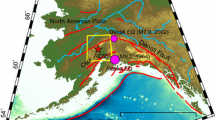Abstract
GPS is frequently used in the monitoring of natural hazards and other geophysical phenomena. Landslide monitoring is one such area in which various GPS methods are tested and various systematic error sources are introduced. In previous studies, one error source introduced on rapid static GPS was the effect of large height differences in GPS positions. In this study, we further investigate how GPS velocities/slip rates are affected by large station height differences when rapid static surveying is used. In order to demonstrate the influences, we used static GPS measurements from the Koyulhisar landslide in central Turkey. Comparison of rapid static GPS solutions with static GPS solutions using BERNESE 5.0 indicates that systematic biases occur in the estimated rapid static GPS deformation rates when the station height difference is large between baseline points. The effect is more significant on the vertical component, whereas it is negligible on the horizontal components. When reducing the height difference between the reference station and the rover stations, rapid static solutions from 15-min sessions show high correlation and similar deformation rates with static positioning solutions.













Similar content being viewed by others
References
Baarda W (1967) Statistical concepts in geodesy. Publication on Geodesy, New Series 2(4), Netherlands Geodetic Commission
Baarda W (1968) A testing procedure for use in geodetic networks. Publication on Geodesy, New Series, 2(5), Netherlands Geodetic Commission
Beutler G, Bock H, Brockmann E, Dach R, Fridez P, Gäde A, Hugentobler U, Ineichen D, Jaeggi A, Meindl M, Mervart L, Rothacher M, Schaer S, Springer T, Weber R (2001) Bernese GPS software version 4.2. In: Hugentobler U, Schaer S and Fridez P (eds), Astronomical Institute, University of Berne, 515 pp
Beutler G, Bock H, Brockmann E, Dach R, Fridez P, Gurtner W, Hugentobler U, Ineichen D, Johnson J, Meindl M, Mervart L, Rothacher M, Schaer S, Springer T, Urschl C (2005) Bernese GPS software version 5.0 draft. In: Hugentobler U, Dach R, Fridez P, Meindl M (eds), Astronomical Institute, University of Berne, 548 pp
Coe JA, Ellis WL, Godt JW, Savage WZ, Savage JE, Michael JA, Kibler JD, Powers PS, Lidke DJ, Debray S (2003) Seasonal movement of the Slumgullion landslide determined from global positioning System surveys and field instrumentation, July 1998–March 2002. Eng Geol 68:67–101
Dixon TH (1991) An Introduction to the global positioning system and some geological applications. Rev Geophys 29(2):249–276
Eckl MC, Snay RA, Soler T, Cline MW, Mader GL (2001) Accuracy of GPS-derived relative positions as a function of inter-station distance and observing-session duration. J Geodesy 75:633–640
Frei E, Beutler G (1990) Rapid static positioning based on the fast ambiguity resolution approach “FARA”: theory and first results. Manuscripta Geod 15:325–356
Gili JA, Corominas J, Rius J (2000) Using global positioning system techniques in landslide monitoring. Eng Geol 55:167–192
Gurtner W, Hugentobler G, Botton S, Rothacher M, Geiger A, Kahle HG, Schneider D, Wiget A (1989) The use of the global positioning system in mountainous areas. Manuscripta Geod 14:53–60
Hastaoglu KO, Sanli DU (2008) Accuracy of GPS rapid static positioning: Application to Koyulhisar landslide, central Turkey. Survey Review (in press)
Hastaoglu KO, Sanli DU, Poyraz F, Ayazli IE (2009) Comparison of estimation methods for tropospheric errors in GPS rapid static method. J Eng Nat Sci 27(4):264–274
Hekimoglu S, Erenoglu RC, Sanli DU, Erdogan B (2009) Detecting configuration weaknesses in geodetic networks. Survey Review (in press)
Hofmann-Wellenhof B, Lichtenegger H, Collins J (1994) GPS, theory and practice, 3rd, rev edn, Springer-Verlag. Wien, New York, p 355
Leick A (1995) GPS satellite surveying, 2nd edn. John Wiley and Sons, New York, p 560
Malet JP, Maquaire O, Calais E (2002) The use of global positioning system techniques for the continuous monitoring of landslides: application to the Super-Sauze earthflow (Alpes-de-Haute-Provence, France). Geomorphol 43:33–54
Matsushima T, Takagi A (2000) GPS and EDM monitoring of Unzen volcano ground deformation. Earth Planets Space 52:1015–1018
Mora P, Baldi P, Casula G, Fabris M, Ghirotti M, Mazini E, Pesci A (2003) Global positioning systems and digital photogrammetry for the monitoring of mass movements: application to the Ca’ di Malta landslide (northern Apennines, Italy). Eng Geol 68:103–121
Moss JL (2000) Using the global positioning system to monitor dynamic ground deformation networks on potentially active landslides. Int J Appl Earth Obs Geoinformation 2:24–32
Moss JL, McGuire WJ, Page D (2000) Ground deformation of a potential landslide at La Palma, Canary Islands. J Volconology Geotherm Res 94:251–256
Niell AE (1996) Global mapping functions for the atmosphere delay at radio wavelengths. J Geophys Res 101(B2):3227–3246
Reilinger R, McClusky S, Vernant P, Lawrence S, Ergintav S, Cakmak R, Ozener H, Kadirov F, Guliev I, Stepanyan R, Nadariya M, Hahubia G, Mahmoud S, Sakr K, ArRajehi A, Paradissis D, Al-Aydrus A, Prilepin M, Guseva T, Evren E, Dmitrotsa A, Filikov SV, Gomez F, Al-Ghazzi R, Karam G (2006) GPS Constraints on Continental Deformation in the Africa-Arabia-Eurasia Continental Collision Zone and Implications for the Dynamics of Plate Interactions. Journal of Geophysical Research-Solid Earth 111 (B5): Art. No. B05411
Roberts C, Rizos C (2001) Mitigating differential troposphere effects for GPS-based volcano monitoring. 5th Int. Symp. on Satellite Navigation Technology, Canberra, Australia, 24–27 July, paper 38, CD-ROM proc
Rührnössl H, Brunner FK, Rotacher M (1998) Modelling of the tropospheric correction for deformation measurements with GPS in Alpine areas. (Modelliering der troposphärischen Korrektur für Deformationsmessungen mit GPS im Alpinen Raum.). Allgemeine Vermessungsnachrichten (AVN) 105(1):14–20 in German
Sanli DU, Engin C (2009) Accuracy of GPS positioning over regional scales. Surv Rev 41(312):192–200
Sanli DU, Kurumahmut F (2008) Accuracy of GPS positioning in the presence of large height differences. In: FIG working week 2008. Available via http://www.fig.net/pub/fig 2008/techprog.htm Accessed 29 Sep 2009
Schon S (2007) Affine distortion of small GPS networks with large height differences. GPS Solutions 11:107–117
Schwarz RC, Snay AR, Soler T (2009) Accuracy assessment of the National Geodetic Survey’s OPUS-RS utility. GPS Solutions 13:119–132
Sendir H, Yılmaz I (2002) Structural, geomorphological and geomechanical aspects of the Koyulhisar landslides in the North Anatolian Fault Zone (Sivas, Turkey). Env Geol 42:52–60
Soler T, Michalak P, Weston ND, Snay RA, Foote RH (2005) Accuracy of OPUS solutions for 1- to 4-h observing sessions. GPS Solutions 10:45–55
Squarzoni C, Delacourt C, Allemand P (2005) Differential single-frequency GPS monitoring of the La Valette landslide (French Alps). Eng Geol 79:215–229
Teke K, Yalcinkaya M, Konak H (2008) Optimization of GPS networks for landslide areas. Fresenius Environ Bull 17(6):664–675
Tut I, Sanli DU, Erdogan B, and Hekimoglu S (2010) Reliability of GPS rapid static positioning, European Geosciences Union (EGU) General Assembly 2010, EGU Abstract, Abstract No: EGU 2010-1200, 2-7 May 2010, Vienna, Austria
Ulusay R, Aydan O, Kilic R (2007) Geotechnical assessment of the 2005 Kuzulu landslide (Turkey). Eng Geol 89:112–128
Volker J, Roberts C, Rizos C, Hasannuddin Z (2002) Low-cost GPS-based volcano deformation monitoring at Mt. Papandayan, Indonesia. J Volcanol Geotherm Res 115:139–151
Yalcinkaya M, Bayrak T (2003) Dynamic model for monitoring landslides with emphasis on underground water in Trabzon Province, northeastern Turkey. J Surv Eng 129(3):115–124
Yalcinkaya M, Bayrak T (2005) Comparison of static, kinematic and dynamic geodetic deformation models for Kutlugun Landslide in northeastern Turkey. Nat Hazards 34:91–110
Yilmaz I (2009) A case study from Koyulhisar (Sivas-Turkey) for landslide susceptibility mapping by artificial neural networks. Bull Eng Geol Environ 68(3):297–306
Acknowledgments
BERNESE 5.0 was provided for GPS data processing by TUBITAK MAM under a contract through a State Planning Organization (SPO) project with the grant 2006 K-120220. Some of the GPS campaigns were also funded by the SPO project. Cumhuriyet University funded Koyulhisar Landslide Project with the Grant M-330 and Kemal Hastaoglu’s studentship in Yildiz Technical University. TUBITAK BIDEB also partly supported Kemal Hastaoğlu with a Ph.D. Grant. We used Google Earth to draw the map of the Koyulhisar landslide. The authors are also grateful to the two anonymous reviewers for their comments and contributions in enhancing the paper.
Author information
Authors and Affiliations
Corresponding author
Rights and permissions
About this article
Cite this article
Hastaoglu, K.O., Sanli, D.U. Monitoring Koyulhisar landslide using rapid static GPS: a strategy to remove biases from vertical velocities. Nat Hazards 58, 1275–1294 (2011). https://doi.org/10.1007/s11069-011-9728-5
Received:
Accepted:
Published:
Issue Date:
DOI: https://doi.org/10.1007/s11069-011-9728-5




